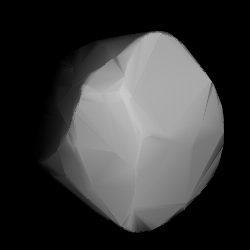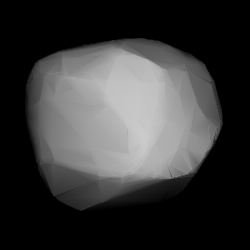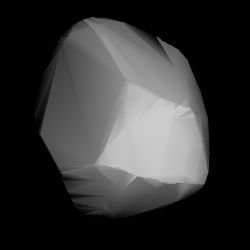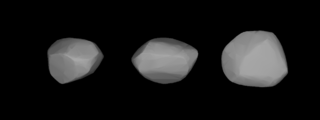
26 Proserpina is a main-belt asteroid discovered by German astronomer R. Luther on May 5, 1853. It is named after the Roman goddess Proserpina, the daughter of Ceres and the Queen of the Underworld. Another main-belt asteroid, 399 Persephone, discovered in 1895, is named after her Greek counterpart. Its historical symbol was a star inside a pomegranate; it is in the pipeline for Unicode 17.0 as U+1CECD .

56 Melete is a large and dark main belt asteroid. It is a rather unusual P-type asteroid, probably composed of organic rich silicates, carbon and anhydrous silicates, with possible internal water ice. The asteroid orbits the Sun with a period of 4.18 years.

57 Mnemosyne is a large main belt asteroid. It is a stony S-type asteroid in composition. This object was discovered by Robert Luther on 22 September 1859 in Düsseldorf. Its name was chosen by Martin Hoek, the director of the Utrecht Observatory, in reference to Mnemosyne, a Titaness in Greek mythology.

67 Asia is a large main belt asteroid. It was discovered by English astronomer N. R. Pogson on April 17, 1861, from the Madras Observatory. Pogson chose the name to refer both to Asia, a Titaness in Greek mythology, and to the continent of Asia, because the asteroid was the first to be discovered from that continent.

154 Bertha is a main-belt asteroid. It was discovered by the French brothers Paul Henry and Prosper Henry on 4 November 1875, but the credit for the discovery was given to Prosper. It is probably named after Berthe Martin-Flammarion, sister of the astronomer Camille Flammarion.

159 Aemilia is a large main-belt asteroid. Aemilia was discovered by the French brothers Paul Henry and Prosper Henry on January 26, 1876. The credit for this discovery was given to Paul. It is probably named after the Via Aemilia, a Roman road in Italy that runs from Piacenza to Rimini.

165 Loreley is a main-belt asteroid that was discovered by C. H. F. Peters on August 9, 1876, in Clinton, New York and named after the Lorelei, a figure in German folklore.

217 Eudora is a large Main belt asteroid. It was discovered by French (Corsican) astronomer J. Coggia on August 30, 1880, in Marseilles, France. It was his fourth asteroid discovery and is named after Eudora, a Hyad in Greek mythology.

242 Kriemhild is a main belt asteroid that was discovered by Austrian astronomer Johann Palisa on 22 September 1884 in Vienna and was named after Kriemhild, a mythological Germanic princess, by Moriz von Kuffner, a Viennese industrialist and sponsor of astronomy.

273 Atropos is a typical Main belt asteroid that was discovered by Austrian astronomer Johann Palisa on 8 March 1888 in Vienna.

340 Eduarda is a main belt asteroid that was discovered by German astronomer Max Wolf on 25 September 1892 in Heidelberg. It was named after German banker and amateur astronomer Heinrich Eduard von Lade.

348 May is a large Main belt asteroid. It was discovered by Auguste Charlois on 28 November 1892 in Nice, and was named for the German author Karl May. This asteroid is orbiting the Sun at a distance of 2.97 AU with a period of 5.12 years and an eccentricity (ovalness) of 0.067. The orbital plane is inclined at an angle of 9.7° to the plane of the ecliptic. During its orbit, this asteroid has made close approaches to the dwarf planet Ceres. For example, in September 1984 the two were separated by 6.3 Gm (0.042 AU).
363 Padua is a main belt asteroid that was discovered by Auguste Charlois on 17 March 1893 in Nice. It was named after the city of Padua, near Venice, Italy.

381 Myrrha is a main-belt asteroid that was discovered by the French astronomer Auguste Charlois on January 10, 1894, in Nice. It has been classified as a C-type asteroid and is most likely composed of carbonaceous material.
442 Eichsfeldia is a large main belt asteroid that was discovered by German astronomers Max Wolf and A. Schwassmann on 15 February 1899 in Heidelberg. It is classified as a C-type asteroid and is probably composed of primitive carbonaceous material.
536 Merapi is a main belt asteroid orbiting the Sun. It was discovered by American astronomer George Henry Peters on May 11, 1904, from Washington, D.C.
563 Suleika is a minor planet orbiting the Sun. Previously designated as 1905 QK, it was discovered by German astronomer Paul Götz on 6 April 1905 from Heidelberg, Germany.

708 Raphaela is a minor planet orbiting the Sun.

747 Winchester is an asteroid, a minor planet orbiting the Sun. It was discovered in 1913, and is named after the town in which it was discovered, Winchester, Massachusetts, in the USA.
799 Gudula is a minor planet orbiting the Sun discovered by German astronomer Karl Wilhelm Reinmuth on 9 March 1915 at the Heidelberg observatory.















